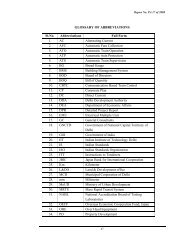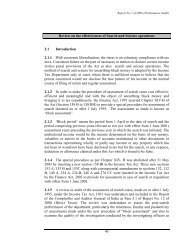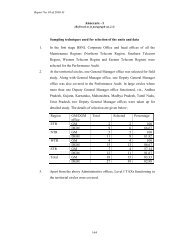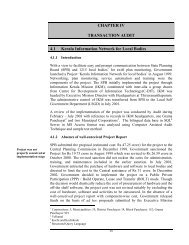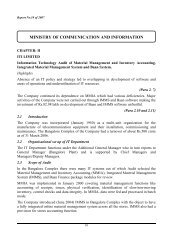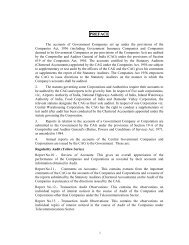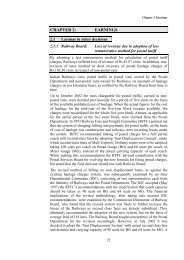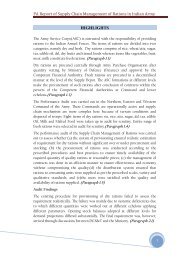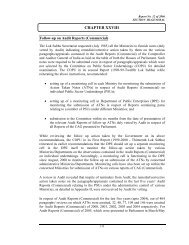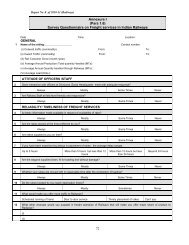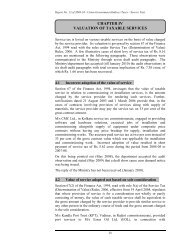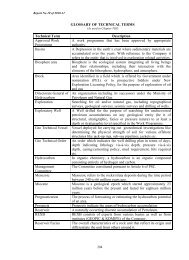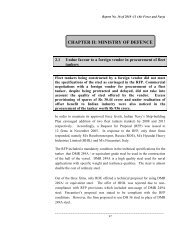CHAPTER IV MAJOR FINDINGS IN TRANSACTION AUDIT ...
CHAPTER IV MAJOR FINDINGS IN TRANSACTION AUDIT ...
CHAPTER IV MAJOR FINDINGS IN TRANSACTION AUDIT ...
You also want an ePaper? Increase the reach of your titles
YUMPU automatically turns print PDFs into web optimized ePapers that Google loves.
Report No.13 of 2006<br />
<strong>CHAPTER</strong> <strong>IV</strong><br />
<strong>MAJOR</strong> <strong>F<strong>IN</strong>D<strong>IN</strong>GS</strong> <strong>IN</strong> <strong>TRANSACTION</strong> <strong>AUDIT</strong>-<br />
EXPENDITURE<br />
(A) Loss/over payment/short recovery/other recoveries at the<br />
instance of Audit<br />
4.1 Excess payment of electricity charges<br />
Failure of seven Secondary Switching Areas under the Punjab Telecom<br />
Circle to claim the admissible rebate on electricity charges under the rules<br />
resulted in excess payment of Rs 2.31 crore to Punjab State Electricity<br />
Board.<br />
7.5 per cent rebate<br />
was admissible for<br />
power supply at 11<br />
KV<br />
Failure to claim<br />
admissible rebate by<br />
seven SSAs in the<br />
Punjab Telecom<br />
Circle resulted in<br />
excess payment of<br />
Rs 2.31 crore<br />
According to Punjab State Electricity Board (PSEB) notification dated January<br />
1997, power consumers falling under the non-residential supply (NRS) category<br />
were to be allowed a rebate of 7.5 per cent of the billed amount if the supply of<br />
power was given at 11 KV, provided the consumer installed its own transformer.<br />
The units of the Company fall under the NRS category.<br />
During Audit (between August 2004 and May 2005) of seven Secondary<br />
Switching Areas (SSAs) at Amritsar, Ludhiana, Pathankot, Patiala, Hoshiarpur,<br />
Ferozpur and Sangrur under the Punjab Telecom Circle it was noticed that though<br />
supply of power was given at 11 KV and BSNL had installed its own<br />
transformers, PSEB did not give the admissible rebate on the billed amounts. The<br />
SSAs failed to claim the admissible rebate resulting in excess payment of<br />
Rs 2.31 crore, as detailed in the Appendix-XVII, for the billing months from<br />
January 1998 to April 2005 in different SSAs.<br />
On this being pointed out by Audit, the General Managers, Telecom (GMsT)<br />
Amritsar, Ludhiana, Patiala, Hoshiarpur, Ferozpur and Sangrur stated that the<br />
matter would be taken up with PSEB for adjustment of excess paid amounts while<br />
GMT Pathankot stated that the matter had been taken up for grant of rebate as per<br />
orders.<br />
Thus the failure of the SSAs to claim admissible rebate on electricity charges<br />
resulted in excess payment of Rs 2.31 crore to PSEB in seven SSAs alone.<br />
The matter was referred to the Ministry in July 2005; its reply was awaited as of<br />
November 2005.<br />
44
Report No.13 of 2006<br />
4.2 Non-disposal of hazardous waste<br />
Telecom Factory, Bhilai failed to dispose off 360.23 MT of zinc dross, a<br />
hazardous waste violating the instructions of the Ministry of Environment<br />
and Forests and resulting in non-realisation of Rs 1.26 crore through its<br />
disposal.<br />
Zinc dross, a by-product of the galvanising process is a hazardous metal waste<br />
which if allowed to accumulate has an adverse impact on ecosystems, including<br />
the human environment. As per the Hazardous Wastes (Management and<br />
Handling) Rules 1989, amended in 2003, issued by the Ministry of Environment<br />
and Forests, such wastes are not to be stored for more than 90 days. Departmental<br />
instructions as adopted by the Company, envisage that zinc dross produced in<br />
telecom factories should be disposed of by offering the same to any Central/State<br />
Government Department/PSU/autonomous body and in case none is willing to<br />
purchase it, it should be disposed of by way of auction after wide publicity, as per<br />
the existing procedures of telecom factories.<br />
The factory<br />
accumulated 360.23<br />
MT of zinc dross, a<br />
hazardous waste, the<br />
net realisable value of<br />
which was Rs 1.26<br />
crore<br />
Audit scrutiny of the records of Telecom Factory, Bhilai (October 2004) revealed<br />
that Management failed to dispose of zinc dross of 360.23 MT generated during<br />
the period 1994-1995 to 2000-01, the net realisable value of which was Rs 1.26<br />
crore (August 2005).<br />
On this being pointed out by Audit, the Chief Accounts Officer, Telecom Factory,<br />
Bhilai, accepted (June 2005) the facts and stated that tenders were floated from<br />
time to time but the rates were not accepted, as they were lower than the reserve<br />
prices.<br />
The reply is not tenable as the Departmental Instructions (April 1993) clearly<br />
stipulate that in case of auction, the price at which the zinc dross was to be<br />
disposed of could be either higher or lower than the reserve price fixed from time<br />
to time, depending on the prevailing market conditions.<br />
Thus by allowing the accumulation of the zinc dross, a hazardous waste, the<br />
Company not only violated the instructions issued by the Ministry of<br />
Environment and Forests but also failed to realise Rs 1.26 crore through its<br />
disposal.<br />
The matter was referred to the Ministry in August 2005; its reply was awaited as<br />
of November 2005.<br />
45
Report No.13 of 2006<br />
4.3 Non-recovery of compensation for damage to underground<br />
cables<br />
Delay in preferring claims by the Chief General Manager, Calcutta<br />
Telephones resulted in non-recovery of compensation of Rs 1.21 crore from<br />
M/s Reliance Infocomm Limited for the cables damaged by the latter.<br />
Rules provide that when the Company’s property is damaged by an outside<br />
agency, compensation should be claimed from the concerned party. Further, the<br />
compensation claim should be levied, taking into account the actual cash outlay<br />
and value of stores utilized in repairing the damage, along with overheads.<br />
RIL on 237 occasions<br />
damaged<br />
underground cables<br />
Delay in lodging<br />
claims by the company<br />
resulted in nonrealisation<br />
of<br />
compensation claim of<br />
Rs 1.21 crore from<br />
RIL<br />
Audit scrutiny (March 2005) of the records of the Chief General Manager (CGM),<br />
Calcutta Telephones revealed that M/s Reliance Infocomm Limited (RIL), while<br />
undertaking digging work, damaged underground cables of the Company on 237<br />
occasions during August 2001 to May 2003. Audit observed that the Area<br />
Managers belatedly intimated (December 2003/January 2004) the Deputy General<br />
Manager (Switching Planning) about damages to the cables. In most of the cases a<br />
formal compensation claim was not lodged with RIL and a consolidated claim for<br />
recovery of compensation of Rs 1.26 crore in respect of 237 cases from RIL was<br />
only lodged in January 2004. The firm while accepting claims (April 2004) for<br />
Rs 4.82 lakh for damages on 19 occasions rejected 192 claims on the ground that<br />
intimation had not been received from Calcutta Telephones regarding damage to<br />
its cables during the project period of RIL.<br />
When delay in lodging the claim was pointed out (March 2005) by Audit, the<br />
Deputy General Manager (Telephone Revenue), Calcutta Telephones stated (July<br />
2005) that necessary steps were being taken to realize the damage charges. He<br />
added that the lower formations of Calcutta Telephones had been instructed to<br />
maintain proper records for such incidents of damage to substantiate their claims.<br />
This indicated that the Company lacked a proper internal control mechanism for<br />
timely lodging of compensation claims.<br />
Thus delay on the part of the CGM to prefer claims resulted in non-recovery of<br />
compensation of Rs 1.21 crore from RIL for the cables damaged by the latter.<br />
The matter was referred to the Ministry in October 2005; its reply was awaited as<br />
of November 2005.<br />
46
Report No.13 of 2006<br />
4.4 Non-recovery of compensation charges for delays in repairing E-<br />
10-B cards<br />
General Managers, Telecom Districts, Rourkela and Bhubaneswar under the<br />
Orissa Telecom Circle failed to recover compensation charges of Rs 87.57<br />
lakh from Indian Telephone Industries for delays in repairing E-10-B cards.<br />
General Managers, Telecom District (GMsTD), Rourkela and Bhubaneswar under<br />
the Orissa Telecom Circle, entered into agreements with M/s Indian Telephone<br />
Industries (ITI) in June 2001 and September 2003, respectively for repair of all<br />
types of cards used in E-10-B exchanges. These agreements were initially for one<br />
year from the dates of commencement and were to be automatically renewed<br />
annually till three years, unless notified otherwise by either party. Clause 7 of the<br />
agreements stipulated levy of compensation charges on ITI for delay in repairing<br />
of cards. Clause 5 of the agreements provided that GMsTD Rourkela and<br />
Bhubaneswar were to pay 10 per cent and 20 per cent respectively of the annual<br />
repair contract (ARC) charges in advance. The balance 90 per cent and 80 per<br />
cent were to be paid in four quarterly instalments, after deducting the<br />
compensation charges.<br />
GMsTD failed to<br />
recover compensation<br />
of Rs 87.57 lakh from<br />
ITI for delays in<br />
repairing of E-10-B<br />
cards<br />
Audit scrutiny (February 2004) of the records of GMTD, Rourkela revealed that<br />
while ITI delayed in repairing 1496 cards, GMTD, Rourkela failed to recover<br />
compensation charges of Rs 15.89 lakh from the quarterly payment of ARC<br />
charges to ITI. Similarly, Audit scrutiny (November 2004) of the records of<br />
GMTD, Bhubaneswar revealed that ITI had delayed in repairing 1169 cards but<br />
GMTD, Bhubaneswar failed to recover the compensation charges of Rs 71.68<br />
lakh from the quarterly payment of ARC charges to ITI. This resulted in nonrecovery<br />
of compensation charges of Rs 87.57 lakh from ITI.<br />
On this being pointed out by Audit, GMTD Rourkela stated (September 2005)<br />
that an amount of Rs 11.48 lakh had been recovered in September 2005 and<br />
recovery of the balance Rs 4.41 lakh was in progress. Divisional Engineer,<br />
E-10-B, Bhubaneswar, stated (July 2005) that the calculation of the compensation<br />
charges was in progress and would be submitted shortly.<br />
The matter was referred to the Ministry in August 2005; its reply was awaited as<br />
of November 2005.<br />
47
Report No.13 of 2006<br />
(B)<br />
Wasteful expenditure on setting up of new exchanges and<br />
expanding existing exchange capacity<br />
4.5 Injudicious expansion of exchanges<br />
The General Managers, Telecom Districts, Ghaziabad under the Uttar<br />
Pradesh (West) Circle and Surendranagar under the Gujarat Circle<br />
injudiciously expanded the equipped capacity of five telephone exchanges,<br />
resulting in under utilization and consequent idle investment of Rs 3.46 crore<br />
on expansion of these exchanges.<br />
Departmental guidelines, as adopted by the Company, after considering a growth<br />
rate of 15 to 20 per cent, advance planning period of one year for expansion of<br />
exchanges and providing equipment required, fixed the average utilization of<br />
exchange capacity up to 5K 1 and beyond 5K lines at 75 percent and between 82<br />
and 85 per cent, respectively.<br />
Exchanges were<br />
expanded<br />
considering a<br />
growth rate of 30<br />
to 40 per cent<br />
resulting in their<br />
under utilisation<br />
Audit scrutiny of the records of the General Managers, Telecom Districts<br />
(GMsTDs), Ghaziabad under the Uttar Pradesh (West) Circle (November 2004)<br />
and Surendranagar under the Gujarat Circle (August 2004) revealed that five<br />
project estimates were sanctioned between June 2001 and November 2002 for<br />
expansion of exchanges. The exchanges were expanded during the period from<br />
April 2002 to March 2003. Audit scrutiny of four project estimates relating to<br />
GMTD, Ghaziabad revealed that an anticipated growth rate of demand of 30 to 40<br />
per cent was considered. However, even after two years of expansion of the four<br />
exchanges by 7K lines, the utilization varied between 57 per cent and 78 per cent.<br />
The working connections in all these exchanges as of October 2004 were such<br />
that the same could have been accommodated from their pre-expansion capacities.<br />
This resulted in idling of Rs 2.31 crore on expansion of exchanges by 7K lines.<br />
Similarly, in the case of the Surendranagar Secondary Switching Area (SSA), the<br />
project estimate relating to Sayla exchange considered an anticipated growth rate<br />
of demand of 32 per cent and even after two years of expansion, the capacity<br />
utilisation of the exchange was only 27 per cent. This resulted in idling of Rs 1.15<br />
crore incurred on expansion by 2K lines.<br />
Under utilisation of<br />
exchanges for two<br />
years resulted in idle<br />
investment of capital<br />
to the extent of<br />
Rs 3.46 crore<br />
On this being pointed out, GMTD, Ghaziabad confirmed the facts and stated<br />
(December 2004) that the excess exchange capacity would be diverted and that in<br />
one case, it had been shifted and commissioned. The Accounts Officer,<br />
Surendranagar SSA replied (April 2005) that marketing agents had been<br />
appointed and all out efforts were being made to load the system to the optimum<br />
level. Thus injudicious expansion of exchanges resulted in under utilization to the<br />
1 1K – 1000 lines<br />
48
Report No.13 of 2006<br />
extent of 9K lines for two years and consequent idle investment of Rs 3.46 crore<br />
as detailed in the Appendix-XVIII.<br />
The matter was referred to the Ministry in October 2005; its reply was awaited as<br />
of November 2005.<br />
4.6 Unproductive expenditure on installation of an exchange<br />
Principal General Manager, Telecom, Coimbatore SSA, installed 1K RSU at<br />
Peelamedu in October 2003, when the Centrex connections released (20) till<br />
September 2005 could have been given from the existing AXE exchange,<br />
resulting in unproductive expenditure of Rs 2.83 crore.<br />
Chief General Manager Telecom (CGMT), Tamil Nadu Telecom Circle,<br />
sanctioned (January 1997) a project estimate for expansion of a new technology<br />
AXE exchange at Peelamedu, Coimbatore Secondary Switching Area from 10K<br />
to 15K lines at a cost of Rs 9.45 crore. However, taking into account the demand<br />
pattern, the Principal General Manager, Telecom (PGMT) Coimbatore, changed<br />
the proposal from expansion of 5K lines to installation of a 1K EWSD Remote<br />
Switching Unit (RSU). The new exchange was commissioned (October 2003) at a<br />
cost of Rs 2.83 crore.<br />
Only 20 subscribers<br />
were availing the<br />
Centrex facility from<br />
the EWSD RSU till<br />
September 2005<br />
though the exchange<br />
was commissioned in<br />
October 2003<br />
PGMT Coimbatore<br />
did not take into<br />
account the<br />
capabilities of the<br />
existing AXE<br />
exchange<br />
Audit scrutiny of the records of the PGMT, Coimbatore revealed that though the<br />
exchange was commissioned in October 2003, no connections were released till<br />
July 2004. Only 20 subscribers were availing the Centrex facility from the EWSD<br />
RSU as on September 2005. When Audit pointed out that these demands could<br />
have been met from the spare capacity available with existing AXE exchange at<br />
Peelamedu, PGMT, Coimbatore replied (July 2005) that it was thought advisable<br />
to install an EWSD RSU so that value added services such as the Centrex * facility<br />
could be provided to the customers. It was also stated that the Centrex facility was<br />
available only in the EWSD switch.<br />
The reply is not tenable since AXE exchange, was also capable of offering<br />
Centrex facility by activating a set of commands but without any additional<br />
equipment. Further, this facility was being offered on AXE exchanges under<br />
Chennai Telephones. Hence, the telephone lines released from 1K EWSD RSU<br />
could have been given from the existing spare capacity of AXE Main Exchange.<br />
Thus the decision of PGMT, Coimbatore to install a 1K EWSD RSU at<br />
Peelamedu was injudicious, resulting in unproductive expenditure of Rs 2.83<br />
crore.<br />
* Centrex is a virtual EPABX, which integrates all the multi located telephone lines (existing and<br />
new) of a subscriber into a single highly functional communication group without any additional<br />
equipment at the subscriber’s premises<br />
49
Report No.13 of 2006<br />
The matter was referred to the Ministry in August 2005; its reply was awaited as<br />
of November 2005.<br />
4.7 Wasteful expenditure on installation of C-DOT exchanges<br />
Telecom District Manager, Banda Secondary Switching Area under the<br />
Uttar Pradesh (East) Telecom Circle failed to commission nine C-DOT<br />
exchanges even after four to five years of their installation, resulting in<br />
wasteful expenditure of Rs 1.96 crore.<br />
Nine exchanges<br />
were installed<br />
during 1999-2001<br />
In order to provide telecom facilities in rural areas, the Telecom District Manager<br />
(TDM), Banda under the Uttar Pradesh (East) Circle sanctioned nine project<br />
estimates (August 1999 to March 2000) for installation of nine C-DOT-256<br />
exchanges. The exchanges were installed between December 1999 and March<br />
2001 at a cost of Rs 1.96 crore.<br />
Audit scrutiny of the records of the Banda Secondary Switching Area (SSA)<br />
revealed that seven exchanges having an installed capacity of 256 connections<br />
each were initially put in service/installed (December 1999 to October 2000)<br />
without media connectivity and worked intermittently with few connections<br />
ranging from 30 to 72 in number. These exchanges could not be commissioned<br />
properly due to non-availability of OFC equipment, control cards and<br />
underground cables. Further, due to non-connectivity with media, the subscribers<br />
could not talk to places outside their village and therefore wanted their telephones<br />
disconnected. Telephone Revenue Account (TRA) section could not issue bills as<br />
giving connections without proper media connection was not justified. Two<br />
exchanges under Simauni and Dehruch were commissioned in March 2005 and<br />
July 2004 after delays of four to five years and were working with only eight and<br />
20 connections, respectively.<br />
On this being pointed out by Audit, the Chief Accounts Officer, Banda SSA<br />
accepted (January 2005) that these exchanges were not in operation. He also<br />
stated that operating these exchanges was no longer remunerative and it was<br />
proposed to cover the area with WLL technology.<br />
Exchanges could not<br />
be used resulting in<br />
infructuous<br />
expenditure of<br />
Rs 1.96 crore<br />
Thus due to lack of proper coordination in commissioning these nine exchanges,<br />
seven exchanges were yet to be commissioned and two were working with a few<br />
telephone connections, resulting in wasteful expenditure of Rs 1.96 crore, as<br />
detailed in the Appendix-XIX, on installation of these exchanges. Consequently,<br />
the objective of providing telephone connections to rural areas also remained<br />
largely unfulfilled.<br />
The matter was referred to the Ministry in August 2005; its reply was awaited as<br />
of November 2005.<br />
50
Report No.13 of 2006<br />
(C)<br />
Idle investment in Land and Buildings<br />
4.8 Idle investment on purchase of land and construction of building<br />
The General Manager, Telecom District, Ghaziabad purchased a piece of<br />
land in July 1997 and constructed a telephone exchange building without any<br />
proposal for installation of an exchange. This resulted in idle investment of<br />
Rs 1.45 crore.<br />
GMTD Ghaziabad<br />
purchased a plot in<br />
1997 for Rs 76.72<br />
lakh and constructed<br />
a telephone exchange<br />
in 2004 at a cost of<br />
Rs 67.95 lakh<br />
There were delays at<br />
every stage of<br />
implementation of<br />
the project<br />
The General Manager, Telecom District (GMTD), Ghaziabad under the Uttar<br />
Pradesh (West) Telecom Circle purchased (July 1997) a plot in Govindpuram, for<br />
opening a telephone exchange at a cost of Rs 76.72 lakh from the Ghaziabad<br />
Development Authority (GDA). The possession of the plot was taken in June<br />
1998 and a telephone exchange building was constructed (February 2004) at a<br />
cost of Rs 67.95 lakh.<br />
Audit scrutiny (November 2004) of the records of GMTD, Ghaziabad revealed<br />
that while possession of the plot was taken in June 1998, the sale deed was<br />
executed in March 2001 after a delay of more than two years due to non<br />
availability of funds from Circle office. GMTD, Ghaziabad sanctioned<br />
(September 2001) the preliminary and detailed estimates for construction of the<br />
telephone exchange building and the building was completed and handed over<br />
(February 2004) to GMTD by the Civil wing. There was no immediate plan<br />
(February 2004) for installation of telephone exchange and it was only in March<br />
2005 that a project estimate for shifting of telephone exchange was sanctioned.<br />
Hence, the building remained unutilised (July 2005).<br />
On this being pointed out by Audit, the Deputy General Manager stated (August<br />
2005) that the Govindpuram exchange would be shifted to the new building after<br />
allotment of cable from the Circle office.<br />
Non-utilisation of<br />
building resulted in<br />
idle investment of<br />
Rs 1.45 crore<br />
Thus the delays at every stage of implementation together with lack of<br />
coordination with the Circle office resulted in idle investment of Rs 1.45 crore on<br />
purchase of land (more than 8 years) and construction of an exchange building<br />
(for more than one and a half years).<br />
The matter was referred to the Ministry in August 2005; its reply was awaited as of<br />
November 2005.<br />
51
Report No.13 of 2006<br />
4.9 Idle investment on construction of telephone exchange buildings<br />
Improper planning and lack of synchronization between Secondary<br />
Switching Areas (SSAs) and the civil wing resulted in non-commissioning of<br />
exchanges and consequent idle investment of Rs 1.44 crore on construction of<br />
telephone exchange buildings.<br />
Three telephone<br />
exchange buildings<br />
were to be completed<br />
by September 2001<br />
Exchange buildings<br />
were completed by<br />
July 2003 but could<br />
not be put to use due<br />
to lack of<br />
synchronisation<br />
The Chief General Manager, Telecommunications, Bihar Circle sanctioned<br />
(during the Year 2000) the construction of three telephone exchange buildings at<br />
Beldaur under Khagaria and Raghopur and Triveniganj under Saharsa Secondary<br />
Switching Area (SSA). The buildings at Beldur and Raghopur, were proposed for<br />
shifting the existing exchanges which were housed in a shed and an optical fibre<br />
cable (OFC) project building respectively. In case of Triveniganj, a new exchange<br />
was to be commissioned. The Civil wing awarded (September 2000) the contracts<br />
for execution of the work and the buildings were to be completed between July<br />
and September 2001.<br />
Audit scrutiny of the records of the Khagaria and Saharsa SSAs revealed that the<br />
buildings were completed after delays of one to two years. The delays were<br />
mainly on account of non-availability of drawings and non-supply of building<br />
materials by the Civil wing. Even after completion of the buildings (December<br />
2002 to July 2003) at a cost of Rs 1.44 crore, these remained unutilized, as the<br />
SSAs did not take them over from the Civil wing. It was further noticed that the<br />
project estimate for shifting and installation of the exchange at Beldaur had not<br />
been sanctioned (December 2004), and in case of Raghopur and Triveniganj, the<br />
estimates were sanctioned only in February 2005. The exchanges were yet to be<br />
commissioned (October 2005).<br />
On this being pointed out by Audit, the Telecom District Manager (TDM),<br />
Khagaria stated (December 2004) that the building at Beldaur had not been taken<br />
over by them because the environmental work for the switch room and the<br />
construction of a boundary wall were still to be done by the Civil wing. The Civil<br />
wing, Khagaria stated that the execution of environmental work had been held up<br />
on account of non-availability of approved drawings from the Circle authorities.<br />
As regards construction of the telephone exchange buildings at Raghopur and<br />
Triveniganj, TDM, Saharsa stated (September 2004) that the Civil wing had not<br />
handed over the buildings to them. Audit scrutiny revealed that the Civil wing had<br />
already requested (March and June 2003) TDM, Saharsa to take over the<br />
buildings. TDM, Saharsa further stated (March 2005) that technical staff of the<br />
OFC project was using the building at Raghopur and the Sub Divisional<br />
Engineer’s office was functioning in two rooms in Triveniganj and the exchange<br />
would be commissioned on receipt of the necessary equipment.<br />
52
Report No.13 of 2006<br />
Non-utilisation of<br />
buildings resulted in<br />
idle investment of<br />
Rs 1.44 crore<br />
Thus due to improper planning and lack of proper synchronization between the<br />
SSAs and the Civil wing, the project for shifting and commissioning of the<br />
exchanges was delayed by four years, resulting in idle investment of Rs 1.44<br />
crore. This also resulted in continuance of telephone exchanges at inappropriate<br />
places like a shed and a cramped project building, besides non-realisation of<br />
potential revenue of Rs 86 lakh per annum in the case of Triveniganj.<br />
The matter was referred to the Ministry in August 2005; its reply was awaited as of<br />
November 2005.<br />
4.10 Idle investment on purchase of land<br />
Construction had not been commenced (June 2005) on land purchased in<br />
March 2000 for a telephone exchange resulting in idle investment of Rs 1.26<br />
crore.<br />
The Patna Regional Development Authority (PRDA) requested (December 1999)<br />
the Principal General Manager Telecom District (PGMTD), Patna to provide a<br />
telephone exchange at Transport Nagar due to high demand for telephone<br />
connections and offered a piece of land measuring 52,920 sq.ft at a cost of<br />
Rs 1.14 crore for the purpose. PGMTD Patna, accepted the proposal and paid<br />
(March 2000) Rs 1.14 crore for the land. The project estimate for installation of<br />
2K new tech. Remote Switching Unit (RSU) was approved (August 2000) at a<br />
cost of Rs 4.50 crore. Further, PGMTD, Patna paid (January 2003) Rs 12.44 lakh<br />
as maintenance cost.<br />
PGMTD, Patna<br />
purchased a plot of<br />
land for Rs 1.26 crore<br />
in March 2000<br />
Audit scrutiny (February 2005) of the records revealed that PGMTD could not<br />
take possession of the plot till April 2003, as the same was not identified/located.<br />
The Committee constituted by GM (D) PTD observed (September 2003) that the<br />
land could be used for shifting of Bahadurpur Exchange and installing Mobile and<br />
WLL BTS instead of having a separate exchange for Transport Nagar. It was also<br />
decided to initially construct a tower and a temporary shed, as construction of<br />
exchange building would take some time. The Civil wing prepared the<br />
preliminary estimate for the project only in January 2005. The construction of the<br />
exchange building thus could not be started even after five years from the release<br />
of payment for the plot.<br />
On this being pointed out by Audit, the Chief Accounts Officer, PGMTD, Patna<br />
replied (June 2005) that though the offer letter was given by PRDA in October<br />
2000, the possession could not be taken in spite of repeated communication with<br />
them due to non-identification of the location of the plot. After taking possession<br />
in July 2003, the plot was developed and used for mobile towers in 2004. It was<br />
further stated that the Civil wing had been asked to submit an estimate for the<br />
telephone exchange and a store godown.<br />
53
Report No.13 of 2006<br />
Non-utilisation of<br />
land for five years<br />
resulted in idle<br />
investment of Rs 1.26<br />
crore<br />
The reply is not tenable, as PGMTD should have addressed these issues, including<br />
site suitability, before making payment for the land. Infact, the rules of the<br />
Company required that when a site was to be purchased, there should be a careful<br />
consideration of all the aspects by not only the Telecom Officers but also by the<br />
Architects and the Civil Engineers of the Company. A suitability certificate was<br />
to be provided jointly by these officers, which required them to personally inspect<br />
the site. Moreover, only a small portion of 4,067 sq.ft out of 52,920 sq.ft was used<br />
for erection of mobile towers. This not only resulted in idle investment of<br />
Rs 1.26 crore, but also defeated the very objective of providing a dedicated<br />
telephone exchange at Transport Nagar, Patna.<br />
The matter was referred to the Ministry in August 2005; its reply was awaited as of<br />
November 2005.<br />
4.11 Idle investment on construction of staff quarters<br />
Staff quarters constructed in Anishabad under the Patna SSA remained idle<br />
for over two years resulting in idle investment of Rs 87.48 lakh.<br />
Chief General Manager Telecommunications (CGMT) Patna, Bihar Circle,<br />
sanctioned (April 1998) construction of 24 Type II and III staff quarters in<br />
telephone exchange compound Anishabad Patna at an estimated cost of Rs 1.03<br />
crore. Civil wing awarded (June 2000) the work contract with scheduled date of<br />
commissioning as December 2001.The work was completed in June 2003 after a<br />
delay of one and a half years mainly due to departmental reasons like nonclearance<br />
of site and non-availability of architectural drawings.<br />
In spite of completion of the work by the Civil wing, the staff quarters were not<br />
handed over to the user unit i.e. Principal General Manager Telecom District<br />
(PGMTD) Patna as the Civil wing did not repair some damages to doors, window<br />
handles and basins and did not replace some stolen ceiling fans.<br />
Non-utilisation of<br />
staff quarters<br />
resulted in idle<br />
investment of<br />
Rs 87.48 lakh<br />
On this being pointed out by Audit, the Civil wing stated that the PGMTD, Patna<br />
had been reminded several times to take over the quarters. However, the office of<br />
the PGMTD stated that a reference had been made to the Civil wing to rectify the<br />
defects noticed by them in the buildings. Thus due to lack of co-ordination<br />
between the Civil wing and the SSA, the staff quarters completed in June 2003<br />
were lying unutilized, resulting in unfruitful expenditure of Rs 87.48 lakh.<br />
Thus due to lack of coordination between the SSA and the Civil wing for utilising<br />
newly constructed quarters resulting in idle investment of Rs 87.48 lakh.<br />
The matter was referred to the Ministry in August 2005; its reply was awaited as of<br />
November 2005.<br />
54
Report No.13 of 2006<br />
4.12 Blocking of capital<br />
The General Manager, Telecom District, Sriganganagar purchased land and<br />
constructed a telephone exchange building without any requirement,<br />
resulting in its idling of capital of Rs 86.24 lakh.<br />
The exchange<br />
building was ready in<br />
February 2002 but<br />
could not be used due<br />
to lack of demand<br />
The General Manager, Telecom District (GMTD), Sriganganagar under the<br />
Rajasthan Telecom Circle sanctioned (July 1999) a project for opening of a 2000<br />
line MAX C-DOT exchange at Sadbhavana Nagar. The justification given in the<br />
project estimate was that the telephone connections working in Sadbhavana Nagar<br />
area were being provided from the existing telephone exchange at Sriganganagar,<br />
which involved laying of five to six kilometers of cable for providing<br />
connections, making it a costly affair.<br />
GMTD, Sriganganagar purchased (August 1999) land at a cost of Rs 47.83 lakh<br />
and constructed (February 2002) a telephone exchange building at a cost of<br />
Rs 38.41 lakh. Audit scrutiny (February 2005) of the records of GMTD,<br />
Sriganganagar revealed that GMTD had gone ahead with the project without a<br />
realistic assessment of demand exclusively for telephone connections in the<br />
Sadbhavana Nagar although the rules stipulate that small exchanges should be<br />
planned only where waiting lists for telephone connections are greater than 50 and<br />
the exchange capacity should be proposed based on a careful assessment of<br />
demand. Subsequently considering the non-profitability of the project, the project<br />
estimate for installation of an exchange was cancelled (June 2004) and it was<br />
proposed to utilise the building for store and repair workshop. Hence, there was<br />
no justification for installation of a 2000 line telephone exchange for Sadbhavana<br />
Nagar.<br />
This resulted in<br />
blocking of capital of<br />
Rs 86.24 lakh<br />
GMTD, Sriganganagar stated (August 2005) that a part of the building was being<br />
used as a temporary store and that it was planned to install a GSM ∗ unit there.<br />
Thus due to improper planning, the land purchased in August 1999 and the<br />
building constructed thereon in February 2002 remained idle, resulting in<br />
blocking of capital of Rs 86.24 lakh.<br />
The matter was referred to the Ministry in October 2005; its reply was awaited as<br />
of November 2005.<br />
4.13 Unfruitful investment on construction of exchange buildings<br />
Telephone exchange buildings under the Patna SSA remained idle for over<br />
one to three years, resulting in unfruitful investment of Rs 81.55 lakh.<br />
The General Manager, now Principal General Manager, Telecom District<br />
(PGMTD), Patna accorded approval in October 1997 and February 2000 for<br />
∗ GSM-Global System for Mobile Communication<br />
55
Report No.13 of 2006<br />
construction of telephone exchange buildings at Mokama and Bikram respectively<br />
although both the exchanges were functioning in departmental buildings.<br />
The Civil wing awarded the works contract and the buildings which were to be<br />
completed by September 1999 at Mokama and by June 2001 at Bikram, were<br />
completed in April 2002 and February 2004 respectively after considerable delays<br />
of over two and a half years. In case of Mokama, two years were lost in<br />
finalization of the site and supply of the architectural drawings to the contractor<br />
and in the case of Bikram, there were delays on account of non-finalization of the<br />
layout plan and architectural drawings by the Civil wing and delays on the part of<br />
the contractor.<br />
No plans to shift the<br />
telephone exchange<br />
to the newly<br />
constructed buildings<br />
resulted in unfruitful<br />
expenditure of<br />
Rs 81.55 lakh<br />
Audit further noticed that PGMTD, Patna failed to take over the newly<br />
constructed telephone exchange buildings from the Civil wing as the existing<br />
exchanges were already functioning in departmental buildings and no plans were<br />
drawn to shift the same to the newly constructed exchange buildings. Thus the<br />
exchange buildings remained idle (March 2005) for over one to three years after<br />
construction, resulting in unfruitful expenditure of Rs 81.55 lakh.<br />
On this being pointed out by Audit, the Divisional Engineer (Planning) stated that<br />
the utilisation of the buildings was being examined and necessary decision would<br />
be taken regarding their taking over from the Civil wing.<br />
Thus due to inadequate planning, buildings constructed at the cost of Rs. 81.55<br />
lakh remained unutilised for over one to three years.<br />
The matter was referred to the Ministry in August 2005; its reply was awaited as of<br />
November 2005.<br />
(D) Other idle/unproductive expenditure/investment<br />
4.14 Idling of Digital Loop Carrier system<br />
Corporate Office of the Company allotted 25 Digital Loop Carrier systems to<br />
the Assam Circle without considering the actual requirement resulting in<br />
idling of 19 systems worth Rs 8.36 crore.<br />
Digital Loop Carrier (DLC) systems are used in access networks to provide<br />
services such as the Integrated Services Digital Network and high speed data<br />
services to customers on existing telephone connections.<br />
Corporate office<br />
allotted 25 DLC<br />
systems to Assam<br />
Telecom Circle<br />
between July 2001<br />
and May 2004<br />
The Corporate office of the Company placed three purchase orders (PO) (July<br />
2001 to May 2004) and allotted 25 DLC systems to the Assam Telecom Circle.<br />
56
Report No.13 of 2006<br />
Audit scrutiny of the records of the Chief General Manager Telecom (CGMT),<br />
and the General Manager Telecom (GMT), Kamrup under the Assam Circle<br />
revealed that the Circle placed an indent (December 2002) for 11 DLC systems on<br />
the Corporate office. The Corporate office instead of allotting 11 systems, allotted<br />
25 DLC systems to the Circle.<br />
Out of the 25 DLC systems received, only six systems were commissioned in four<br />
Secondary Switching Areas (SSAs) under the Circle. This resulted in idling of 19<br />
DLC systems worth Rs 8.36 crore. Even in the case of the six DLC systems<br />
commissioned it was noticed that the average utilisation was only to the extent of<br />
18 per cent as of September 2005.<br />
Allotment of DLC<br />
systems more than<br />
the requirement<br />
resulted in idling of<br />
19 DLC systems<br />
worth Rs 8.36 crore<br />
On this being pointed out by Audit, the Deputy General Manager (Planning and<br />
Operations), Assam Circle stated (September 2005) that 14 DLC systems were<br />
allotted without any requisition from the Circle and efforts were being made to<br />
commission the remaining systems.<br />
Thus procurement of DLC systems by the Company’s Corporate office in excess<br />
of the demand of the Assam Circle and the failure of the Circle to realistically<br />
assess its own requirement before placing the requisition on the Corporate office<br />
resulted in excess procurement and consequent idling of 19 DLC systems worth<br />
Rs 8.36 crore.<br />
The matter was referred to the Ministry in August 2005; its reply was awaited as<br />
of November 2005.<br />
4.15 Blocking of funds due to non-commissioning of optical fibre<br />
routes<br />
Lack of proper planning and coordination led to non-commissioning of 31<br />
OFC routes in Uttar Pradesh (East) and Gujarat Telecom circles resulting in<br />
blocking of funds amounting to Rs 3.31 crore.<br />
In order to provide optical fibre connectivity to various telephone exchanges and<br />
to synchronous digital hierarchy (SDH) ring networks, high-density polyethylene<br />
(HDPE) pipes and optical fibre cables (OFC) were laid (1999 to 2004) along 38<br />
routes of five Secondary Switching Areas (SSAs) at Azamgarh, Mau, Hardoi,<br />
Banda and Sultanpur under the Uttar Pradesh (East) Telecom Circle. Similarly<br />
OFC cables were laid along six routes of Valsad and Amreli SSA under Gujarat<br />
Circle during 2002-2003.<br />
Optical fibre<br />
cable routes were<br />
not<br />
commissioned<br />
despite laying of<br />
HDPE pipes and<br />
OFC at a cost of<br />
Rs 2.66 crore<br />
Audit scrutiny (April 2004 to March 2005) revealed that out of the above 38<br />
routes under Uttar Pradesh (East) Circle, 25 routes were completed during 2002-<br />
04 at an expenditure of Rs 2.66 crore but could not be commissioned till<br />
September 2005. Examination of the records of the SSAs revealed that eight<br />
57
Report No.13 of 2006<br />
routes were not commissioned as the telephone exchanges were no longer<br />
required due to coverage by mobile or WLL services. Fifteen routes planned for<br />
SDH network could not be commissioned due to non-receipt of SDH equipment<br />
from the Corporate office, while the balance two routes could not be<br />
commissioned due to non-completion of cable jointing.<br />
OF cable laid<br />
between July 2002<br />
and March 2003 at a<br />
cost of Rs 64.98 lakh<br />
could not be<br />
commissioned for<br />
want of OF<br />
equipment<br />
This resulted in<br />
blocking of funds of<br />
Rs 3.31 crore<br />
In case of GMsT, Valsad and Amreli though OFC laying works along six routes<br />
were completed between March 2002 and March 2003 at a cost of Rs 64.98 lakh,<br />
these were not commissioned due to non-receipt of OFC terminal equipment from<br />
the Circle Office as of May 2005. In Amreli SSA the cable-laying work was<br />
completed between March 2002 and January 2003 but the requisition to the Circle<br />
Office for procurement and supply of OF equipment was placed only in July<br />
2004. However, rules stipulate that all necessary activities connected with the<br />
execution of a project should be initiated simultaneously so as to avoid blocking<br />
of funds.<br />
On this being pointed out by Audit, the Assistant General Manager (Telecom<br />
Planning), Uttar Pradesh (East) Telecom Circle, while accepting the facts, stated<br />
(September 2005) that the infrastructure of pipes and cables laid could not be used<br />
due to changes in the policy of the Company. He further stated that instructions<br />
had been issued to the SSAs to utilize the partially completed routes for SDH ring<br />
network or Mobile/WLL purposes. The Assistant General Managers, Valsad and<br />
Amreli SSAs also accepted (April-May 2005) the facts.<br />
Thus lack of proper planning and coordination led to non-commissioning of 31<br />
OFC routes in Uttar Pradesh (East) and Gujarat Telecom Circle, resulting in<br />
blocking of funds of Rs 3.31crore.<br />
The matter was referred to the Ministry in August/October 2005; its reply was<br />
awaited as of November 2005.<br />
4.16 Wasteful expenditure on idle stores<br />
Idling of line and wire stores in Mangalore SSA for more than two years<br />
since their receipt resulting in wasteful expenditure of Rs 3.11 crore on their<br />
procurement.<br />
Rules provide that stores purchased must not be held in excess of requirement<br />
beyond a reasonable period and stores remaining in stock for over a year should<br />
be considered surplus. In order to ensure the observance of this rule, annual<br />
inspections must be carried out by responsible officers, who must submit reports<br />
of surplus and obsolete stores to the authorities competent to issue orders for their<br />
disposal. Further it was decided (April/July 2000) to lay five pair cable for<br />
providing new telephone connections instead of erecting new overhead<br />
alignments since it was more economical and circles were instructed not to<br />
procure overhead material to the full extent as per norms.<br />
58
Report No.13 of 2006<br />
Audit scrutiny (January 2005) of the records of the General Manager<br />
Telecommunications (GMT), Mangalore revealed that based on the purchase<br />
orders placed by the Karnataka Circle, line and wire stores meant for overhead<br />
alignments valuing Rs 3.11 crore were received by the GMT from the Circle<br />
Telecom Stores Depot, Bangalore during 1998-99 to 2002-03 as follows:<br />
Line and wire stores<br />
worth Rs 3.11 crore were<br />
lying unutilised for more<br />
than two years.<br />
Period of receipt<br />
1998-01 43.83<br />
2001-02 17.91<br />
2002-03 248.80<br />
Total 310.54<br />
Value of stores<br />
(Rs in lakh)<br />
These stores were lying unutilized even after two years of their last receipt.<br />
On this being pointed out (January 2005) by Audit, the Chief General Manager,<br />
Telecommunications, (CGMT) Karnataka Circle stated (September 2005) that the<br />
line and wire stores were procured as per the development programme of the year<br />
2002-03. He further added that the line material could not be used as projected<br />
due to instructions issued (May 2003) by the Company’s Corporate office,<br />
stipulating that connections beyond 2.5 km involving more line materials from the<br />
last distribution point need not be energized and were to be covered by WLL. Due<br />
to this the requirement of line and wire material had fallen drastically. The CGMT<br />
added that action would be taken to divert the material to other needy places. It<br />
was further stated that permission of the Corporate Office had been sought to<br />
dispose off excess materials through the CGM, Telecom Stores, Kolkata.<br />
The reply is not tenable as the instructions of May 2003 were only a continuation<br />
of the earlier orders of April and July 2000 to minimise the use of overhead line<br />
material. Hence the Company was aware of the declining necessity for overhead<br />
materials but procured line materials worth Rs 2.49 crore during 2002-03. Further<br />
no action was taken to divert the stores to needy units and only on being pointed<br />
out by Audit, Circle office and other SSAs were requested to divert the idle stores.<br />
Thus non-observance of the instructions coupled with inaction of the GMT to<br />
utilize or divert the stores to needy units resulted in wasteful expenditure of<br />
Rs 3.11 crore.<br />
The matter was brought to the notice of the Ministry in October 2005; its reply<br />
was awaited as of November 2005.<br />
59
Report No.13 of 2006<br />
4.17 Infructuous expenditure on payment of electricity charges<br />
Karnataka, Madhya Pradesh, Chhattisgarh and Tamil Nadu Telecom circles<br />
failed to review and modify their contracted electricity demand on the basis<br />
of actual consumption resulting in payment of minimum demand charges of<br />
Rs 1.29 crore over actual consumption.<br />
Failure to review the<br />
contracted demands<br />
and modify them<br />
resulted in<br />
infructuous<br />
expenditure of<br />
Rs 1.29 crore<br />
Audit scrutiny of the records of 10 Secondary Switching Areas (SSAs) under the<br />
Madhya Pradesh and Chhattisgarh circles, Electrical Division II under the Tamil<br />
Nadu Circle and seven SSAs under the Karnataka Circle revealed that contracted<br />
demands were more than the required demands and minimum demand charges on<br />
higher contracted demands continued to be paid (October 2005) resulting in<br />
infructuous expenditure of Rs 1.29 crore as shown in the Appendix-XX.<br />
On this being pointed out by Audit, heads of SSAs in the Madhya Pradesh and<br />
Chhattisgarh circles, while accepting the facts stated (May 2004 to June 2005)<br />
that action would be taken to minimize the demand charges. They further stated<br />
that the matter for revision of contract demand was being pursued with the State<br />
Electricity Board. The Principal Chief Engineer (Electrical), Electrical Zone,<br />
Tamil Nadu Circle stated (July 2005) that on the basis of the instructions issued<br />
by their Electrical Division, the Gudiatham, Vellore and Ambur SSAs had<br />
reduced their contracted demands during May 2002 to September 2003 and all the<br />
SSAs were again advised to take appropriate steps to reduce the contracted<br />
demand. Heads of SSAs in the Karnataka Circle, while accepting the facts, stated<br />
(September 2005) that their contracted demand had been reduced in December<br />
2004 and that the matter would be taken up with their higher authorities for<br />
further reduction. Audit noticed that the demand was still on the higher side even<br />
after reduction.<br />
Although the Company issued (November 2001) instructions for monitoring of<br />
energy consumption in telephone exchange buildings, persistence of these<br />
deficiencies indicated that the internal control mechanism at the level of SSAs<br />
was weak.<br />
The matter was referred to Ministry in October 2005; its reply was awaited as of<br />
November 2005.<br />
60
Report No.13 of 2006<br />
4.18 Unfruitful expenditure on procurement of power plants<br />
Chief General Manager, Telecom Stores, Kolkata allotted 70 power plants of<br />
100 A to Andhra Pradesh, Orissa and Kolkata circles out of which 52 power<br />
plants worth Rs 1.17 crore developed faults on being put to use resulting in<br />
their idling.<br />
The Corporate office of the Company issued (April 2001) instructions to the Chief<br />
General Manager Telecom Stores (CGMTS) Kolkata to take action for<br />
procurement of power plants of 100A for rural networks in different circles.<br />
CGMTS, Kolkata placed (November 2001/December 2001) purchase orders on<br />
M/s Infinity for procurement of 70, 100A power plants for Andhra Pradesh,<br />
Orissa and Jharkhand Circle.<br />
Fifty two power<br />
plants supplied by<br />
M/s Infinity were<br />
lying idle for various<br />
reasons<br />
Test check in Audit revealed that 52 power plants supplied by M/s Infinity were<br />
lying idle since January 2002/August 2002 in different exchanges of Andhra<br />
Pradesh, Orissa and Jharkhand circles as:<br />
• The Mosfets used in power plants and diodes were failing due to<br />
variation in load<br />
• The power plant modules were not able to take I/P voltage above 480<br />
V.<br />
• The power plants failed during prolonged power cuts.<br />
• Power plants were not able to withstand frequent power fluctuations.<br />
• Power plants were faulty since the date of installation and continued to<br />
default even after rectification by supplier.<br />
• Power plants were functioning smoothly at an exchange equipped with<br />
an AVR (Automatic Voltage Regulator) but were not functioning in<br />
rural exchanges where A.C. mains voltage fluctuation was more.<br />
Further, it was also observed that some of the faulty power plants of Infinity make<br />
were replaced by power plants of ITI make and these were working satisfactorily.<br />
On this being pointed out by Audit, the user units, while accepting the facts,<br />
stated (June 2003 and September 2004) that while some power plants were lying<br />
idle from the dates of installation due to defects, others had become faulty after<br />
working for a few months. CGMTS Kolkata stated (August 2005) that as and<br />
when complaints were received, the firm was directed to repair the plants.<br />
Unfruitful<br />
expenditure of<br />
Rs 1.17 crore on<br />
power plants lying<br />
idle due to its faulty<br />
performance<br />
The reply of the Management is not tenable, as 52 power plants were lying idle<br />
due to faults. Thus the procurement of power plants without taking into account<br />
the voltage fluctuations and other technical parameters of the areas in which these<br />
were to be installed resulted in their faulty performance and resulted in unfruitful<br />
expenditure of Rs 1.17 crore<br />
61
Report No.13 of 2006<br />
The matter was referred to the Ministry in August 2005; its reply was awaited as<br />
of November 2005.<br />
4.19 Imprudent investment<br />
The decision to invest surplus funds of Rs 200 crore in M/s ITI was neither<br />
based on sound commercial judgement nor was in the best financial interests<br />
of the Company.<br />
Company invested<br />
Rs 200 crore in<br />
cumulative<br />
redeemable<br />
preference share of<br />
ITI<br />
The Company invested (March 2003) surplus funds of Rs 200 crore in seven<br />
percent cumulative redeemable preference shares of M/s Indian Telephone<br />
Industries Ltd. (ITI) redeemable at par in five equal installments at the end of the<br />
third, fourth, fifth, sixth and seventh years. The decision for investment was taken<br />
in an emergency meeting (March 2003) of the Board of Directors on a request<br />
received from ITI and on the basis of a recommendation of the Department of<br />
Telecommunications (DoT)<br />
Audit scrutiny of the records of the Company revealed that the decision to invest<br />
surplus funds in ITI was not based on sound commercial judgment and was not in<br />
conformity with the instructions laid down by DPE as explained below:<br />
1. The investment was for an unduly long period of seven years as against the<br />
prescribed period of one year by DPE.<br />
Company’s decision<br />
was in violation of<br />
DPE’s directives and<br />
was not in the best<br />
financial interest of<br />
the \Company<br />
2. The financial position of ITI on the date of investment (March 2003) was not<br />
sound as the half yearly results showed (September 2002) a loss of<br />
Rs 142 crore. The firm had projected a loss of Rs 73 crore for 2002-03<br />
whereas as per DPE guidelines, investment decision should be based on sound<br />
commercial judgement and there should be no element of speculation on yield<br />
obtaining from the investment.<br />
3. Credit rating by a reputed organization before investing in ITI was not<br />
obtained. As per DPE guidelines the investment can be made only in highest<br />
secured instruments rated by a reputed agency.<br />
The Management<br />
stated that the<br />
investment was made<br />
at the behest of DoT<br />
and based on the<br />
financial projections<br />
made by ITI<br />
On this being pointed out by Audit, the Management stated that:<br />
• the investment was made on the recommendation of DoT.<br />
• ITI had the highest credit rating accorded by M/s ICRA and Fitch Rating.<br />
• the financial projections submitted by ITI were also considered.<br />
The reply of the Management is not tenable because of the following reasons:<br />
62
Report No.13 of 2006<br />
• Company should have taken the investment decision based on sound<br />
commercial judgment and not merely based on the recommendations of the<br />
administrative Ministry.<br />
• The rating by M/s ICRA done in November 2002 was for Rs 94 crore bonds<br />
of ITI and not for preference shares.<br />
• The rating by M/s Fitch was for short-term borrowings having tenure of less<br />
than one year and not for longer periods of investment. Besides, the rating was<br />
not valid at the time of the investment, i.e. March 2003.<br />
• The fact that ITI did not have sufficient cash to redeem Bonds of Rs 94 crore<br />
clearly indicated that adequate safeguards were not considered at the time of<br />
investment.<br />
• The Company was aware of the fact that ITI had actually incurred loss of<br />
Rs 55.42 crore ♦ for the year 2001-02 and as per half yearly result ending<br />
30 September 2002, the Company showed loss of Rs 142.25 crore.<br />
Company lost<br />
interest of at least<br />
Rs 70 lakh<br />
ITI was incurring losses since 2001-02 and had not paid dividend of Rs 14 crore<br />
for the year 2003-04. Thus the Company not only lost the interest income of at<br />
least Rs 70 lakh per annum ∗ on the dividend Income (assuming that the dividend<br />
on cumulative preference share will eventually be paid) but also lost the<br />
opportunity of investing the funds in alternative secure investment options.<br />
The matter was referred to the Ministry in July 2005; its reply was awaited as of<br />
November 2005.<br />
4.20 Idle investment on purchase of software<br />
Principal General Manager, Bangalore Telecom District procured Oracle 8i<br />
Relational Database Management System software without considering its<br />
compatibility with the existing ‘Trichur’ billing package, resulting in idle<br />
investment of Rs 61.54 lakh.<br />
Non-compatibility of<br />
Oracle 8i RDBMS<br />
software with the<br />
Trichur billing<br />
package<br />
The Computer Billing Centre, Bangalore Telecom District was using Oracle 7.3.4<br />
Relational Database Management System (RDBMS) software for billing of<br />
telephone revenue. In order to speed up the billing process and to ensure faster<br />
system response time, the Chief General Manager (CGM), Karnataka Circle,<br />
decided (May 2001) to upgrade the entire system. The Principal General Manager<br />
(PGM), Bangalore Telecom District placed (January 2002) a purchase order on<br />
M/s Tata Infotech for supply, installation and commissioning of hardware and<br />
♦ The profit after tax of Rs 21.58 crore for 2001-02 was arrived at after taking into account the<br />
anticipated grant-in-aid which did not fructify.<br />
∗ Interest calculated at the rate of 5 per cent per annum<br />
63
Report No.13 of 2006<br />
Oracle 8i software. The vendor was also made responsible for porting of billing<br />
data from the existing server to the new server. The total cost of the hardware and<br />
software was Rs 2.06 crore with the stipulated date of delivery as eight weeks<br />
from the date of placing the purchase order.<br />
Audit scrutiny (May 2004) of the records of PGM, Bangalore Telecom District,<br />
revealed that though Oracle 8i RDBMS software was installed in October 2002, it<br />
could not be utilized till March 2005 due to its non-compatibility with the existing<br />
Trichur billing package. As a result, billing data could not be migrated from the<br />
existing package to Oracle 8i, resulting in idle investment of Rs 61.54 lakh<br />
towards the cost of procuring Oracle 8i.<br />
Idle investment of<br />
Rs 61.54 lakh due to<br />
non-utilisation of<br />
Oracle 8i RDBMS<br />
software<br />
On this being pointed out by Audit, Chief Accounts Officer, Computer Billing<br />
Centre, Bangalore Telecom District, while accepting the facts, stated (June 2004)<br />
that the efforts to modify the application software were not successful but a<br />
proposal to migrate the existing data to Oracle 8i and clustering the database was<br />
under progress. He further stated (March 2005) that phases of process to be<br />
adopted for migration of entire database and application to Oracle 8i was in<br />
progress.<br />
Thus the decision of PGM, Bangalore Telecom District to procure Oracle 8i<br />
without considering its compatibility with the existing Trichur billing package not<br />
only resulted in idle investment of Rs 61.54 lakh, but also defeated the objective<br />
of speeding up the billing process.<br />
The matter was referred to the Ministry in August 2005; its reply was awaited as<br />
of November 2005.<br />
(E)<br />
Avoidable expenditure/payment<br />
4.21 Avoidable expenditure on procurement of PIJF cable<br />
The Corporate office of the Company failed to avail the benefit of two per<br />
cent additional discount offered by bidders for centralized payment, resulting<br />
in avoidable expenditure of Rs 11.88 crore on procurement of PIJF<br />
underground cable.<br />
The Company invited (June 2003) open tenders for procurement of 120 LCKM ♣<br />
PIJF ∗ underground cables of 21 sizes for the year 2003-2004. The Committee for<br />
Evaluation of Tenders (CET) observed that the prices approved in the earlier<br />
♣ lakh conductor kilometre<br />
∗ polythene insulated jelly filled<br />
64
Report No.13 of 2006<br />
tender during 2002-03 were lower and recommended the offering of a weighted<br />
average rate of Rs 4.80 crore per LCKM as against the weighted average rate of<br />
Rs 5.74 crore per LCKM quoted by L-1. Accordingly, advance purchase orders<br />
(APO) were issued (January 2004) to 30 eligible and short-listed bidders for<br />
116.87 LCKM at the recommended rate. All the bidders conveyed their nonacceptance<br />
of the APO, stating that the prices were not workable.<br />
Two per cent<br />
additional discount<br />
was offered by the<br />
bidders for<br />
centralized payments<br />
Thereafter, a price negotiation committee (PNC) was constituted and based on its<br />
recommendation, a revised APO was issued at the weighted average rate of<br />
Rs 5.11 crore per LCKM, which was also not accepted by the bidders.<br />
Subsequently, an Empowered Committee was constituted (February 2004) by the<br />
Board of Directors to negotiate with five L-1 bidders of different sizes of cables.<br />
The Committee negotiated with the bidders and recommended a weighted average<br />
rate of Rs 5.42 crore per LCKM. The same was approved by the competent<br />
authority and revised APOs were issued in March 2004. After receiving the<br />
acceptance of the APOs from 25 bidders, authorizations were issued (March<br />
2004) to telecom circles for placement of detailed purchase orders for a total<br />
quantity of 94.992 LCKM plus add on quantity of 17.243 LCKM at a cost of<br />
Rs 608.31 crore.<br />
Audit scrutiny (June to August 2005) of the records of the Corporate office of the<br />
Company revealed that during negotiations, a two per cent additional discount<br />
was offered by four L-1 bidders, if centralized payments were made by the circles<br />
instead of the Secondary Switching Areas (SSAs). This was not considered by the<br />
PNC on the ground that it would be a deviation from bid conditions. Audit further<br />
observed that the empowered committee did not consider the above offer,<br />
although in the previous tender for procurement of PIJF cable for 2002-03, the<br />
Corporate office had agreed to centralized payment by relaxing the payment<br />
conditions in the bid documents during price negotiations.<br />
Centralized payments<br />
were not considered.<br />
The two per cent<br />
discount could not be<br />
availed of resulting in<br />
avoidable<br />
expenditure of<br />
Rs 11.88 crore<br />
Thus failure of the company to avail of the benefit of the additional two per cent<br />
discount offered by the bidders for centralized payment resulted in avoidable<br />
expenditure of Rs 11.88 crore on procurement of 109.570 LCKM of PIJF<br />
underground cable up to August 2005.<br />
On this being pointed out by Audit, the Management stated (September 2005) that<br />
the PNC and the Empowered Committee did not consider the additional discount<br />
of two per cent as it was a deviation from the tender condition and considering it<br />
could have resulted in legal complications. It was also stated that in the previous<br />
tender such a request was considered as an exceptional case, which could not be<br />
made a practice. Further, it was mentioned that the discount for all sizes of cables<br />
offered by the L-1 bidders worked out to 2.58 per cent whereas the prices<br />
finalised were about 5.58 per cent less than the prices quoted by the L-1 bidders<br />
and as such, the Company was not put to any loss.<br />
65
Report No.13 of 2006<br />
The reply of the Management is not tenable as centralized payments were made in<br />
the previous tender also without any discount being availed on this account. The<br />
question of legal complications also would be hypothetical, as centralized<br />
payment in relaxation of payment condition in the bid documents was resorted to<br />
earlier. Further, the additional discount of two per cent offered by the bidders was<br />
for centralized payment and was over and above the general reduction of 5.58 per<br />
cent in the prices finalised by the Company.<br />
The matter was referred to the Ministry in September 2005; its reply was awaited<br />
as of November 2005.<br />
4.22 Avoidable extra expenditure on procurement of PLB HDPE<br />
pipes<br />
Chief General Manager, Telecom Stores, Kolkata procured permanently<br />
lubricated high density polyethylene (PLB HDPE) pipes at higher rates<br />
during 2001-2004 which resulted in avoidable excess expenditure of Rs 1.76<br />
crore.<br />
The Company while issuing detailed guidelines relating to decentralised<br />
procurement of stores emphasized (June 2001) that the procurements should be<br />
done on reasonable rates and heads of circles were to assess the reasonableness of<br />
the rates obtained in the tenders by comparing them with the rates of previous<br />
procurements as also the current market trends.<br />
The Chief General Manager, Telecom Stores (CGMTS), Kolkata invited tenders<br />
for procurement of PLB HDPE pipes during 2001 to 2004. Based on the rates<br />
approved by the Stores Purchase Committees (SPCs), purchase orders were<br />
placed during October 2001 to February 2004.<br />
Failure to compare<br />
the basic rates of<br />
PLB HDPE pipes<br />
with other circles<br />
resulted in higher<br />
expenditure of<br />
Rs 1.76 crore<br />
The basic rates fixed by CGMTS, Kolkata, for procurement of the PLB HDPE<br />
pipes were much higher than those fixed by CGMT, Rajasthan Telecom Circle,<br />
during the same period. Thus, failure to compare the basic rates of PLB HDPE<br />
pipes with other circles resulted in avoidable extra expenditure of Rs 1.76 crore as<br />
shown in Appendix -XXI.<br />
On this being pointed out by Audit, the Chief Accounts Officer, (Budget),<br />
CGMTS stated (March 2004 and January 2005) that with the decentralisation of<br />
the procurement process, the circles were to procure their requirements by<br />
inviting their own tenders. Further, he stated that in the open tender system, the<br />
purchaser was to either accept the L1 rate or offer such suitable counter offer rate<br />
as per the recommendations of the SPC so that the stores could be procured in<br />
time.<br />
66
Report No.13 of 2006<br />
The reply of the Management is not tenable as in an open tender system, SPCs<br />
was expected to assess the reasonableness of the rates obtained in tender after<br />
comparing it with the rates of previous procurements and also the current market<br />
trends. The rates obtained by other circles are a good indicator of current market<br />
trends.<br />
Thus the failure of CGMTS, Kolkata to examine the reasonableness of the rates<br />
obtained in the tenders led to avoidable extra expenditure of Rs 1.76 crore during<br />
the years 2001-04.<br />
The matter was referred to the Ministry in July 2005; its reply was awaited as of<br />
November 2005.<br />
4.23 Excess expenditure on cable laying works<br />
Malappuram Secondary Switching Area under the Kerala Circle allowed the<br />
contractor’s bidding percentage applicable for labour rates on purchase of<br />
bricks from PSUs for cable laying works resulting in excess expenditure of<br />
Rs 81.69 lakh.<br />
As per the agreements between the Company and three Public Sector<br />
Undertakings (PSUs) ∗ for laying of underground cables in different exchange<br />
areas of the Malappuram Secondary Switching Area (SSA) under the Kerala<br />
Circle, the Company was to pay the PSUs the actual cost of the work plus<br />
overhead charges. The schedule of labour rates prepared by the PSUs and<br />
accepted by the General Manager Telecommunications (GMT) was adopted as the<br />
basis for inviting tenders from the sub-contractors through whom the PSUs<br />
carried out the work. The tenders were finalized on the bidding percentages ♣<br />
quoted by the sub-contractors. The accepted bidding percentages ranged from 79<br />
to 103 percent above the rates included in the schedule of labour rates, depending<br />
on the exchange area where the cable laying work was carried out.<br />
The cost of bricks for<br />
cable laying works<br />
done through the<br />
PSUs was abnormally<br />
higher as compared<br />
to those of private<br />
contractors.<br />
Audit scrutiny (September 2004) of the records of GMT, Malappuram SSA<br />
revealed that in the schedule of rates for labour and material, the rates for labour<br />
on which biddings percentage was payable included the rate for supply of bricks<br />
for mechanical protection as well. Thus, even though bricks should not have been<br />
classified under ‘labour’, these rates became eligible for payment of the bidding<br />
percentage. As a result, the cost of bricks became unreasonably high for works<br />
carried out by the PSUs compared to those undertaken by private contractors<br />
engaged by the Company in the SSA. The cost of bricks for cable laying executed<br />
through private contractors ranged between Rs 5.94 to Rs 7.50 per metre<br />
∗ Hindustan Cables Limited (HCL), Indian Telephone Industries Limited (ITI) and<br />
Telecommunications Consultants India Limited (TCIL)<br />
♣ Bidding percentage represents the margin of the sub-contractors over and above the adopted<br />
basic schedule of labour rates.<br />
67
Report No.13 of 2006<br />
longitudinally and Rs 11.88 to Rs 15.50 per metre transversely. However,<br />
although the basic rates for PSUs worked out to Rs 7.00 longitudinally and Rs<br />
14.00 transversely but after allowing the bidding percentage ranging from 79 to<br />
103 percent, the effective rate became between Rs 12.53 to Rs 14.21<br />
longitudinally and Rs 25.06 to Rs 28.42 transversely per metre. Audit noticed<br />
excess expenditure of Rs 81.69 lakh in respect of 14 cases for work executed by<br />
PSUs pertaining to the years 2001 to 2004, as compared to the rates of private<br />
contractors.<br />
On this being pointed out, the Chief General Manager Telecommunications<br />
(CGMT), Kerala Circle replied (August 2005) that the tender percentage was<br />
approved considering the turnkey projects in totality and that compared to the cost<br />
of work done through private contractors, the rates offered by the PSUs were<br />
reasonable.<br />
The reply is not tenable since GMT, Malappuram, should have analyzed and split<br />
the schedule of rates correctly between labour and material before adopting them<br />
as the PSUs were asked to quote percentage on the basic rate for labour only.<br />
Further, a comparision of the cost of cable laying work executed through private<br />
contractors in the Manjeri exchange area of the Malappuram SSA with rates<br />
applied for the PSUs revealed that the latter was higher by Rs 1.37 lakh of which<br />
Rs 1.10 lakh was due to the difference in the cost of bricks alone.<br />
Thus the failure of GMT Malappuram in segregating the schedule of labour rates<br />
between labour and materials before adopting them resulted in excess expenditure<br />
of Rs 81.69 lakh in cable laying works executed through the PSUs.<br />
The matter was referred to the Ministry in September 2005; its reply was awaited<br />
as of November 2005.<br />
68



